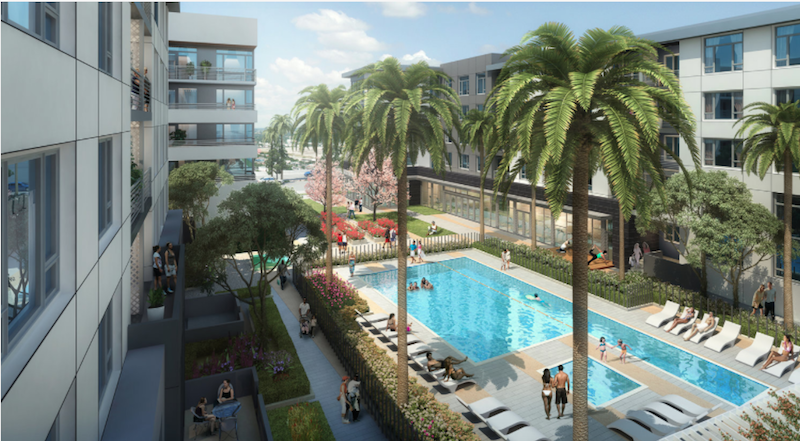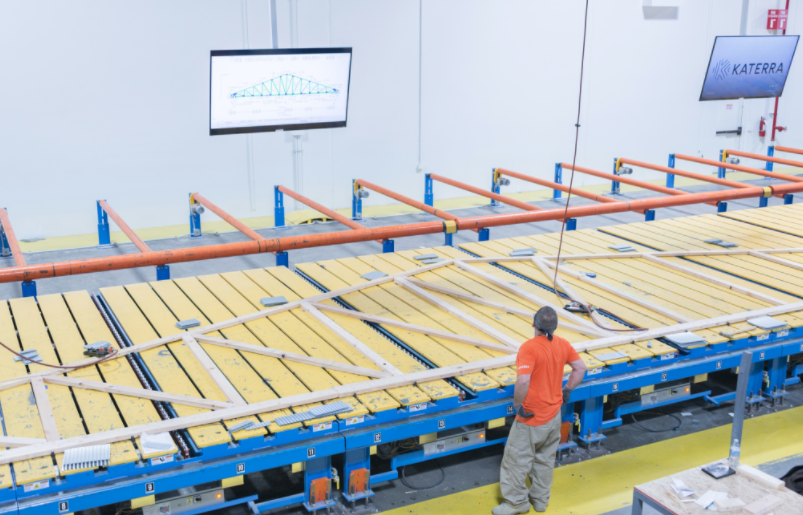By this time next year, Katerra—a technology startup whose end-to-end business model combines prefabrication, architectural, and construction services primarily for multifamily housing—expects to have six manufacturing plants up and running, including its first mass timber factory, a 250,000-sf building under construction on 29 acres in Spokane, Wash.
That plant, when fully operational in early 2019, will be capable of producing about 4.6 million cubic feet of cross-laminated timber annually. The plant’s size is comparable to CLT factories operating in Europe. “We’re going all in on CLT,” says Trevor Schick, who oversees Katerra’s supply chain, lighting, renovation, and commercial rollout activities.
Katerra’s initial success—it booked $1.3 billion in business last year—and its aggressive growth posture have attracted several high-profile investors, most prominently Japan’s SoftBank, from whose $100 billion Vision Fund Katerra recently raised $865 million in its latest round of financing.
SoftBank is steadily investing in tech-oriented companies that are impacting the built environment. In December, it paid $9.3 billion to acquire a 15% stake in Uber Technologies. It owns the robotics manufacturer and research firm Boston Dynamics. Last summer, SoftBank invested $200 million in the indoor farming enterprise Plenty. And it holds a $4.4 billion stake in WeWork, the cosharing office developer.
TechCrunch reported that the venture-capital world fully expects SoftBank to raise another $100 billion for future investments soon.
In-house design team and consortium
The Menlo Park, Calif.-based Katerra is already among the country’s largest GCs. The housing markets it serves include multifamily, senior and student living, and master-planned developments. Katerra’s largest customer is The Wolff Company, a real estate private equity firm that focuses on the multifamily sector, and whose executive chairman Fritz Wolff was one of Katerra’s Co-founders.
“Having a lead customer is important, given the investment we’re making in factories, IT, and so forth,” says Schick.
Katerra currently produces wall panels, roof and floor trusses, cabinets, and countertops from its factory in Phoenix, which began production in early 2017. That facility features Katerra’s Design Showroom, where clients can view a full suite of products and interior design solutions, including fully finished apartment units made entirely from Katerra-supplied products.
 Union Bay South in Carson, Calif., designed by Architects Orange, will offer 357 residential units, with four- and five-story wood framed buildings wrapping two separate concrete parking structures. The building, currently under construction, will include 30,000 sf of retail. Katerra is providing construction, management, and materials. Image: Katerra
Union Bay South in Carson, Calif., designed by Architects Orange, will offer 357 residential units, with four- and five-story wood framed buildings wrapping two separate concrete parking structures. The building, currently under construction, will include 30,000 sf of retail. Katerra is providing construction, management, and materials. Image: Katerra
Last June, Katerra acquired Nystrom Olson, a boutique architectural studio in Spokane. And six months later, it announced the forming of a design consortium whose members include Michael Green of Michael Green Architecture, a leader in mass timber architectural design; Andrea Leers of Boston-based Leers Weinzapfel Associates, which has also designed buildings using mass timber; Ted Flato of Lake|Flato in Texas; and Joe Greco of Lord Aeck Sargent, a full-service architecture and design firm with six offices.
With Green, Katerra is working on the design and construction of the new Hospitality Center in association with the Community Cancer Fund, Ronald McDonald House and Kootenai Health (Walden House) in Coeur d’Alene, Idaho.
Schick tells BD+C that, aside from the CLT plant in Washington, the other facilities Katerra moves into or builds this year will be conventional wood panel and truss factories. Its next mass timber plant is likely to be located in the Southeastern U.S., although Schick didn’t say when construction for that might start.
Leaning toward mass production
Katerra started as a materials supplier, with sourcing offices in Asia and Mexico. But the company soon realized that it needed a “larger scale” to get its cost model right, says Schick. That meant taking more control over the design, production, construction, and logistics of what it sold.
Technology has been the key to that transformation. Before joining Katerra, Schick spent over 15 years in the electronics industry, most recently as senior vice president at Hewlett-Packard involved in global supply chain and quality. One of Katerra’s Co-founders, Michael Marks, had been CEO of an electronics company now called Flex. A third Co-founder, Jim Davidson, founded Silver Lake, a technology investment firm.
Marks is convinced that building construction would benefit greatly from mass production techniques that are common in electronics and automotive manufacturing. Consequently, Katerra uses a kit-of-parts design system that it combines with prefabricated components production and onsite assembly.
The company’s technology platforms include SAP HANA, a market analytics platform that mines data from real estate and construction; a mobile app that connects its workforce in the field; and industrial IoT tools that optimize jobsite activity and track inventory.
 Katerra is building its first mass timber factory, a 250,000-sf building in Spokane, Wash., which will be able to produce 4.6 million cubic feet of product annually. Image: Katerra
Katerra is building its first mass timber factory, a 250,000-sf building in Spokane, Wash., which will be able to produce 4.6 million cubic feet of product annually. Image: Katerra
Schick says the company currently has 12 multifamily projects under way, ranging from 200 to 400 housing units per project. Sometime this year, he says the company plans to enter the hotel construction sector. Katerra also wants to build schools eventually.
As for projects using mass timber, Schick believes that demand among developers, contractors, and cities can only go up. He notes that the International Code Council has a vote scheduled for April to amend the 2021 International Building Code to allow for the use of CLT for buildings up to 18 stories. (Currently, CLT is limited in the U.S. to buildings no higher than six stories.)
In Washington State, ESB Bill 5450, which has passed both chambers of the legislature and is on the governor’s desk to sign, creates a section in the state statute defining qualifying mass timber products. It also directs the State Building Code Council to adopt rules for the use of mass timber in residential and commercial building, consistent with application national and international standards.
Katerra is already doing fire, earthquake, and wind sheer testing of CLT panels that it can make on its 60-foot-long by 12-foot-wide press.
Related Stories
| Aug 11, 2010
Housing America's Heroes 7 Trends in the Design of Homes for the Military
Take a stroll through a new residential housing development at many U.S. military posts, and you'd be hard-pressed to tell it apart from a newer middle-class neighborhood in Anywhere, USA. And that's just the way the service branches want it. The Army, Navy, Air Force, and Marines have all embarked on major housing upgrade programs in the past decade, creating a military housing construction boom.
| Aug 11, 2010
Loft Condo Conversion That's Outside the Box
Few people would have taken a look at a century-old cigar box factory with crumbling masonry and rotted wood beams and envisioned stylish loft condos, but Miles Development Partners did just that. And they made that vision a reality at Box Factory Lofts in historic Ybor City, Fla. Once the largest cigar box plant in the world, the Tampa Box Company produced boxes of many shapes and sizes, spec...
| Aug 11, 2010
World's tallest all-wood residential structure opens in London
At nine stories, the Stadthaus apartment complex in East London is the world’s tallest residential structure constructed entirely in timber and one of the tallest all-wood buildings on the planet. The tower’s structural system consists of cross-laminated timber (CLT) panels pieced together to form load-bearing walls and floors. Even the elevator and stair shafts are constructed of prefabricated CLT.
| Aug 11, 2010
CityCenter Takes Experience Design To New Heights
It's early June, in Las Vegas, which means it's very hot, and I am coming to the end of a hardhat tour of the $9.2 billion CityCenter development, a tour that began in the air-conditioned comfort of the project's immense sales center just off the famed Las Vegas Strip and ended on a rooftop overlooking the largest privately funded development in the U.
| Aug 11, 2010
Giants 300 Multifamily Report
Multifamily housing starts dropped to 100,000 in April—the lowest level in several decades—due to still-worsening conditions in the apartment market. Nonetheless, the April total is below trend, so starts will move progressively back to a still-depressed 150,000-unit pace by late next year.
| Aug 11, 2010
The softer side of Sears
Built in 1928 as a shining Art Deco beacon for the upper Midwest, the Sears building in Minneapolis—with its 16-story central tower, department store, catalog center, and warehouse—served customers throughout the Twin Cities area for more than 65 years. But as nearby neighborhoods deteriorated and the catalog operation was shut down, by 1994 the once-grand structure was reduced to ...
| Aug 11, 2010
Gold Award: Westin Book Cadillac Hotel & Condominiums Detroit, Mich.
“From eyesore to icon.” That's how Reconstruction Awards judge K. Nam Shiu so concisely described the restoration effort that turned the decimated Book Cadillac Hotel into a modern hotel and condo development. The tallest hotel in the world when it opened in 1924, the 32-story Renaissance Revival structure was revered as a jewel in the then-bustling Motor City.







